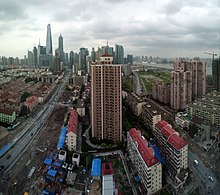Zhong Fong (novel series)
[3] His investigation of brutal murders by the so-called Dim Sum Killer leads to a new inquiry into the death of his wife,[3] in which the detective is himself implicated,[4] causing emotional turmoil,[5] exacerbated by the recent return to Shanghai of her lover, Canadian stage director Geoffrey Hyland.
[2][4] Now officially blamed for the death of his wife,[4] Zhong is a "convicted killer"[7] and a "traitor" condemned to two and a half years in prison and then exile "beyond the Wall" to a remote and impoverished village in northwestern China[7][8][9] near the Mongolian border.
Two years into his incommunicado exile, Zhong Fong receives a warning telegram from his friend Lily in Shanghai, and two Party men throw him into the trunk of a car.
[7] They drive south for two days to Xi'an,[10] the ultimate destination Lake Ching, a large fresh water lake two hours west of Xi'an, where the authorities have a special assignment for him that "no one else wants" but which piques his own interest,[8] partly because it may help restore his former status: the massacre of a boat-full of seventeen foreign scientists and businessmen months earlier and the more recent disappearance of the original investigator assigned to the case.
[11] Zhong Fong has been reinstated as head of Shanghai District's Special Investigations unit, is recently married, and has a baby girl, Xiao Ming.
Two abortion clinics are bombed, one in Huashan Hospital, with notes found in English suggesting the bomber is motivated by religion.
[12] Zhong enlists the aid of Robert Owens, a lawyer turned antique smuggler searching for his orphaned sister.
"[16][2] Meanwhile, he is being watched by the Master of the Guild of Assassins, who is intent on avenging the Dim Sim Killer, who died at the detective's hands nine years earlier.
[4] Rotenberg's Shanghai is a "most unconventional setting" for the mystery genre, a city of many millions of people "making the tricky transition to capitalism.
Throughout the series, Zhong often relies on what he learned from observing her rehearsals, including those for a production of Twelfth Night in which she played Olivia, and had an affair with her director, Geoffrey Hyland.
He is murdered in his second appearance in the series, but referenced occasionally later, as Zhong recalls what he learned watching his rehearsals with Fu Tsong.
[22] On killing the character off, Rotenberg said: "it was more fun than I thought it would be (although the actual Geoffrey Hyland, a former student of mine who is a famous director in South Africa, was disappointed).
[26][note 2] Rotenberg had six weeks until rehearsals began, and used this time to explore the city with his translator: "Instead of visiting all the usual tourist sites, he went into all the small, dark alleys and chalked up impressions.
"[4] Rotenberg recalled: "Here was a city that was actively involved in moving from being ignored by the great powers in Beijing to becoming the centre of Asian capitalism... You could feel it all around you.
The kernel for this mammoth timeline was Rotenberg's chance discovery of a children's book that mentioned Silas Hordoon, an Iraqi Jew who arrived in Shanghai and soon scandalized the city, first by marrying his Chinese mistress, and then when they adopted almost 40 area orphans.
[37] It is a "personal favourite" of fellow crime fiction author Michael J. McCann,[38] Less impressed is Donna Lypchuk, who condemned The Hua Shan Hospital Murders in her review for its attitude towards and depiction of "East Asian women" and Chinese people in general, asserting that it read "like a speedily written treatment for a movie" and that it was "riddled with stereotypes and clichés that make fun of Chinese people's mannerisms and the way they speak.





